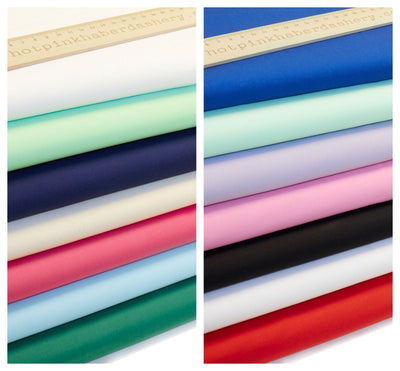How to Quilt: A beginners guide
Helen's Hot Pink Haberdashery
How To Quilt: a beginners guide
Welcome to Helen's Hot Pink Haberdashery ...amongst my busy days of caring for a newborn, chasing a toddler, walking the dog and running the day to day of our online shop, I'm putting pen to paper, or rather fingers to keys to bring you my new blog. If you're needing inspiration for craft projects, tips on how to make your first quilt or advice on choosing the best products for your makes, you're in the right place.
Our shop selling vintage inspired fabrics and pre cut patchwork squares began with an inherent love for Textiles and a habit of perusing Birmingham rag market and buying far too much fabric than our bijoux house could hold. The cutting of pretty fabrics into patchwork squares kick started our online presence, so this is where my blog will begin. If you have always wanted to make your own patchwork quilt, blanket or throw but just don't know where to begin, read on, I'm here to help.
How to Quilt: a beginners guide
What will you need?
My instructions are based on using x100 pre cut 10x10cm patchwork squares, therefore suitable for making a patchwork quilt of approximately one metre square.



I have chosen our pretty pink mix
pink polyester Gutterman thread,
glass head craft pins,
two metres of blue and pink vintage floral fabric
pink bias binding,
tape measure
light batting fabric / wadding.
Follow the links to buy these products for your own quilt.
How to Quilt: preparing your fabric and creating your design
The first steps in learning how to quilt involve preparing your fabrics and choosing your design. Using the pre cut squares makes this stage more simple. No pre-washing is necessary when using polycotton and pre-cuts. It is sometimes recommended for cottons due to possible shrinkage.
Each pack of pretty pink squares contains a range of co-ordinating fabrics, so your layout can't go too wrong. If you are using your own fabric selections and cutting your own pieces, look online for inspiration. Pinterest is great for this. Check out my boards for ideas.
Piecing your design
Once you have the layout of your quilt decided, you can begin the process of piecing or sewing the squares together. When you have gained the confidence and ability to complete this step with accuracy, you really have the essence of how to quilt sorted.


Begin with piecing each horizontal row of squares first, sewing each vertical seam to create these rows. Remember squares should be placed right sides together so the seam is hidden from view. I used a matching pink Gutterman polyester thread, which I find runs nicely in my machine to sew each seam.
Once the horizontal rows are complete, press (not iron) each seam to the side, on the reverse of your fabric. This will create a crisp finish and reduce bulk.
Now to begin creating your finished quilt, you need to match the vertical seams of each horizontal row. Pin the rows in place and measure the 1/4" allowance. Stitch and press the seams.
How to quilt: creating your layers

Choose a light weight batting fabric for the centre of the quilt and layer all of these together. Use pins or safety pins every few inches apart to hold the layers in place ready for sewing. You do not need to do 'right sides together' at this point, as the binding will hide the edges.
How to Quilt: top stitching
Now your layers are temporarily secure, it is time to top stitch your design. You have a few choices during this stage,
- stitch freely, ignoring the pattern of the quilt
- stitch repeated horizontal / vertical lines
- stitch following the pattern / patches of the quilt
- stitch in the ditch of the seam
- stitch next to the seam
- use a matching thread
- use a contrasting thread
These decision will depend on the style of quilt you want to achieve. A traditional look for patchwork is sewing in the ditch of the seam, with a matching thread. Contrasting threads and free stitching looks great on quilts made from scraps or smaller squares / rectangles
You can find examples of our customers makes' in our gallery.
How to Quilt: finishing touches
Now your quilted layers are stitched it is time to seal the edges with binding and add any decorative touches you wish. Our pretty floral fabrics rarely need any further work, but if you wanted to add greater decoration, for example buttons, or hand embroidery, its probably best to do this before you create the layers.
I hope this guide to how to quilt has been simple and easy to follow. We would love to hear your feedback, or any other guides that you need; I am happy to help if I can. If you do create your own quilt masterpiece, please share it with us!
Happy Quilting and hope to see you again,
Helen x 







Love to find out where u get accessories for ur quilting machines ? thank U
Leave a comment